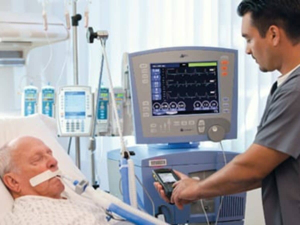Mechanical Ventilation


Mechanical Ventilation in the ICU: Indications, Modes, and Management
Mechanical ventilation (MV) is a life-saving intervention for patients with respiratory failure or compromised airway protection. Here’s a concise, evidence-based overview tailored for clinical practice:
Indications for Mechanical Ventilation
MV is initiated for respiratory failure or airway protection, including:
- Hypoxemic Respiratory Failure:
- PaO₂ <8 kPa (60 mmHg) or SpO₂ <90% despite oxygen therapy.
- Causes: ARDS, pneumonia, pulmonary edema.
- Hypercapnic Respiratory Failure:
- PaCO₂ >8 kPa (60 mmHg) with acidosis (pH <7.25).
- Causes: COPD exacerbation, neuromuscular disorders.
- Non-Respiratory Indications:
- Airway protection (e.g., altered consciousness, trauma).
- Postoperative support (e.g., major surgery).
- Shock or multi-organ failure requiring sedation.
Clinical Triggers:
- Respiratory rate >35/min or <5/min.
- Vital capacity <15 mL/kg or tidal volume <5 mL/kg.
- Exhaustion, labored breathing, or declining mental status136.
Types and Modes of Ventilation
- Invasive Ventilation (Endotracheal/Tracheostomy Tube):
- Volume-Control (VCV): Preset tidal volume; risks barotrauma.
- Pressure-Control (PCV): Preset pressure; reduces lung injury.
- Assist-Control (AC): Full ventilator support with patient-initiated breaths.
- Non-Invasive Ventilation (NIV):
- CPAP/BiPAP: For COPD, cardiogenic pulmonary edema.
- Advanced Modes:
Key Complications
- Ventilator-Induced Lung Injury (VILI):
- Barotrauma (pneumothorax), volutrauma (excessive tidal volume).
- Patient-Ventilator Asynchrony (PVA):
- Hemodynamic Effects:
- Reduced venous return → hypotension (esp. with high PEEP).
- Management: Fluid resuscitation, reduce PEEP, or disconnect ventilator temporarily3.
- Ventilator-Associated Pneumonia (VAP):
Weaning and Extubation
- Readiness Criteria:
- Reversal of underlying cause, adequate oxygenation (PaO₂/FiO₂ ≥150), and hemodynamic stability.
- Spontaneous breathing trials (SBTs) on minimal support (e.g., PSV 5–8 cmH₂O)26.
- Challenges:
- Prolonged MV → diaphragmatic atrophy, critical illness polyneuropathy.
- Failed extubation predictors: Rapid shallow breathing index (RSBI) >105, weak cough28.
Optimizing Ventilation Strategies
- Lung-Protective Ventilation:
- Sedation and Paralysis:
- Minimize sedation to prevent delirium; reserve neuromuscular blockade for severe ARDS.
- PEEP Titration:
Emerging Concepts
- Respiratory Drive Management: Excessive patient effort may worsen lung injury (P-SILI); balance sedation to avoid over-assistance or under-assistance4.
- ECMO Integration: For refractory ARDS or as a bridge to transplant3.
Conclusion
Mechanical ventilation requires balancing oxygenation, ventilation, and patient-ventilator synchrony while minimizing complications. Tailor strategies to the underlying condition, prioritize lung protection, and initiate weaning early.
Consult with Our Team of Experts Now!
At DrStemCellsThailand (DRSCT)‘s Anti-Aging and Regenerative Medicine Center of Thailand, we emphasize comprehensive evaluations and personalized treatment plans of Cellular Therapy and Stem Cells for managing various health conditions. If you have questions about Mechanical Ventilation or would like more information on our services, consult with our experts today!
Consult with Our Team of Experts Now!
References1 WFSA Guidelines |2 AAST |3 MSD Manual |4 Thai Journal of Critical Care |6 JAMA |7 Cleveland Clinic |8 StatPearls
Citations:
- https://resources.wfsahq.org/wp-content/uploads/uia-16-AN-INTRODUCTION-TO-MECHANICAL-VENTILATION-IN-THE-INTENSIVE-CARE-UNIT.pdf
- https://www.aast.org/resources-detail/mechanical-ventilation-in-intensive-care-unit
- https://www.msdmanuals.com/professional/critical-care-medicine/respiratory-failure-and-mechanical-ventilation/overview-of-mechanical-ventilation
- https://he02.tci-thaijo.org/index.php/ccc/article/view/259350
- https://www.ncbi.nlm.nih.gov/books/NBK539742/
- https://jamanetwork.com/journals/jama/fullarticle/2784957
- https://my.clevelandclinic.org/health/treatments/15368-mechanical-ventilation
- https://www.ncbi.nlm.nih.gov/books/NBK448186/















